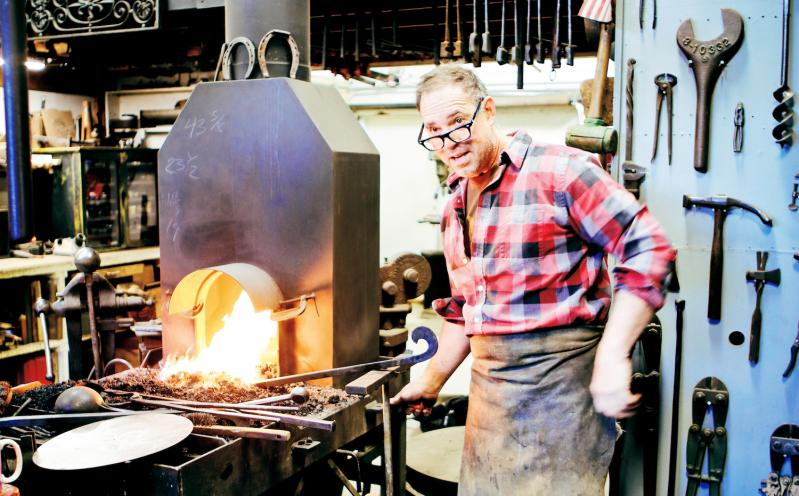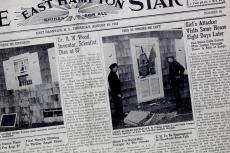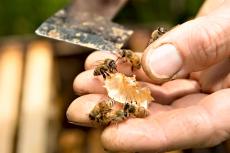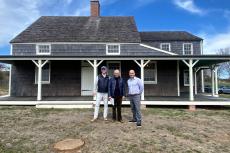Sparks will be flying in Springs on Saturday, when the Parsons Blacksmith Shop finally reopens after a two-year pandemic hiatus. The smithy, James DeMartis, ready for the day’s work in his knee-length leather apron, will be back at the centuries-old forge, hammering hot steel into hooks, nails, and horseshoes to delight the holiday weekend crowds.
Opening the tiny building, which, like the Springs Library next to it, belongs to East Hampton Town, wasn’t as easy as just unlocking the doors. It began last October during a celebration of the life of Ruth Appelhof, the longtime director of Guild Hall and, through her mother, a direct descendant of Charles Parsons, the original village blacksmith, and ended with a small band of relatives, historians, and town officials — all of them determined, in the words of Jackie Wilson, secretary of the Springs Historical Society, to “put the shop back on the map.”
Deanna Tikkanen, president of the historical society, and Prudence Carabine, the director of East Hampton’s Historical Farm Museum — cousins, and proud members of the Parsons clan — were instrumental. “I think we should open it up,” Ms. Carabine recalled telling the group at the memorial ceremony, “and a cheer went up . . . and Deanna said, ‘Give it a try.’ ”
Two more rainmakers joined them before long: Helen Harrison, director of the Pollock-Krasner House and Study Center in Springs, and Steve Long, executive director of the East Hampton Historical Society. “We ended up with nine people,” said Ms. Carrabine, “and we formed Friends of the Blacksmith Shop.”
They didn’t need a lot of money, she said, “just energy and will.” What they did need, though, was liability insurance. East Hampton Town Councilwoman Kathee Burke-Gonzalez, who lives in Springs, helped with that, and with a required special events permit.
“We had to go through quite a palaver to get the insurance,” Ms. Wilson recalled, “but it’s all come together.”
“It became bigger and better,” Ms. Carabine agreed. “We came up with a map of hot spots in Springs, historical and cultural, as a gift for people. No admission, but donations welcome.”
The blacksmith, Mr. DeMartis, an architectural “metalsmith” in real life with a workplace on Springs-Fireplace Road and a client list that includes Martha Stewart, the New York Botanical Garden, and Manhattan’s three-Michelin-starred restaurant Eleven Madison Park, will be at the furnace from 10 a.m. to 2 p.m., one Saturday each month through the summer. Among other skills, he’ll demonstrate how blacksmiths in Revolutionary days used a bellows to blow air on the fire, making it burn higher and hotter — just as he does every year for Springs School fourth graders studying Colonial America.
Blacksmithing, for all its quaint old-timeyness, may in fact be an up-and-coming trade. A few weeks ago, Mr. DeMartis told a recent visitor to his studio, a wide-eyed boy of about 11 or 12 ventured in, “looking to practice and work.” Nor has he been he the only one: “There’s a lot of interest, in part because of television and the internet. Also video games. Minecraft. There’s a blacksmithing world within the Minecraft world. Often, I can tell when kids have a Minecraft background — they know a lot about blacksmithing.”
They may be looking for a challenge, too; there’s plenty of that at the forge. “If you don’t seize the moment,” Mr. DeMartis said, “it’s too late, until you heat the metal again and get it soft again. The metal, in other words, has a window of opportunity to manipulate it while it’s hot, and as it cools, you lose that ability. You have to strike while the iron’s hot!”




